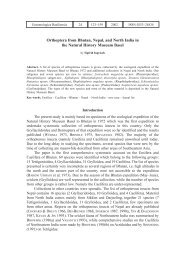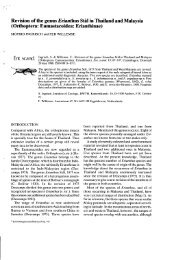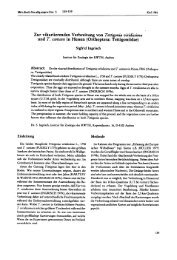the DORSA virtual museum - Sigfrid Ingrisch
the DORSA virtual museum - Sigfrid Ingrisch
the DORSA virtual museum - Sigfrid Ingrisch
You also want an ePaper? Increase the reach of your titles
YUMPU automatically turns print PDFs into web optimized ePapers that Google loves.
478 Leupl, K.-H.; RrnoB, K. & INcnIscn, S.: Repatriation of knowledqe about insectsTaxonomic literature is scattered over numerous journals and books which are often noteasily available because most of <strong>the</strong> classical references but also many of <strong>the</strong> new publicationsare held only in a few libraries worldwide. A recent bibliography on Orthoptera listsover 14,000 titles with taxonomic significance (INcnrscrr &'W'rner'rsn 2004). Moreover<strong>the</strong> knowledge of <strong>the</strong> diversity of insects has greatly multiplied since <strong>the</strong> introductionof <strong>the</strong> binominal nomenclature nearly 25O years ago. For <strong>the</strong> Orthoptera alone, <strong>the</strong>number of known species raised from only 59 taxa in LrNNns' (1758) genus Gryllus toalmost 30,000 species group names that are currently listed in <strong>the</strong> Orthoptera SpeciesFile (osf2x.orthoptera.org). Toge<strong>the</strong>r with <strong>the</strong> increase of knowledge, <strong>the</strong> definitions of<strong>the</strong> species concept has changed repeatedly and taxonomic methods have shown greatprogress. It is thus understandable that historical descriptions are usually insufficient roidentify specimens at hand. Fortunately, descriptions of biological species are based ontype specimens. In former times, travelling to several <strong>museum</strong>s or loan of specimenswere necessary to compare specimens for identification of new material.'With <strong>the</strong> rise of<strong>the</strong> world-wide web, it is now possible to provide <strong>museum</strong> information on-line, <strong>the</strong>rebyfacilitating access to type material, pictures or any o<strong>the</strong>r information related with typespecimens (Rrnoe 2OO3).xL1-14'..'aa,a'. 15 - 37I 38 - 7'1: 72 - 115116-268I 269 - 477Fig. 1: Distribution o[ Orthoptera rype specimens (including Para- and Lectotypes) housed in GermanMuseum collections. Note <strong>the</strong> high number of rypes from Africa, South East Asia and Australia, collectedin <strong>the</strong> last centuries. fFrom Riede 2003].German researchers shared a significant part in exploring <strong>the</strong> Orthoptera fauna of<strong>the</strong> world. Examples for significant historical expeditions are those of Hemprich andEhrenberg to North Africa and N7est Asia (Kruc 1830-1832), Buchholz 7872-1875 toGuinea (Grnsrencrnn 1883), Graeff 1879-1880 to Guinean islands (Knauss 1890),Preuss 1891 to Cameroon (Kanscn 1891a, b), Kling and Biittner 1888-1891 toTogo (Kanscla 1894), Kiikenthal 1893-1894 to <strong>the</strong> Malayan Archipelago (BnuNNrn1898), Voeltzkow 1889-1895 to Madagascar (Saussunr 1899), Filchner to China andTibet 1903-1905 (KenNv 1908), Schlaginhaufen to New Guinea (Kenr.w 1912), <strong>the</strong>German Central-Africa Expedition I 907- I 908 (RnHN 19 | 4), <strong>the</strong> Kaiserin-Augustaf uss-Expeditionto New Guinea 1912-1913 (e.g. KenNv 1928), and Ramme's revisions ofAfrican, Sou<strong>the</strong>ast Asian, Sou<strong>the</strong>ast European and'West Asian Acrididae (e.g. Rervrvre1929, I94I, l95l). Due to those and many o<strong>the</strong>rs including modern expeditions,





